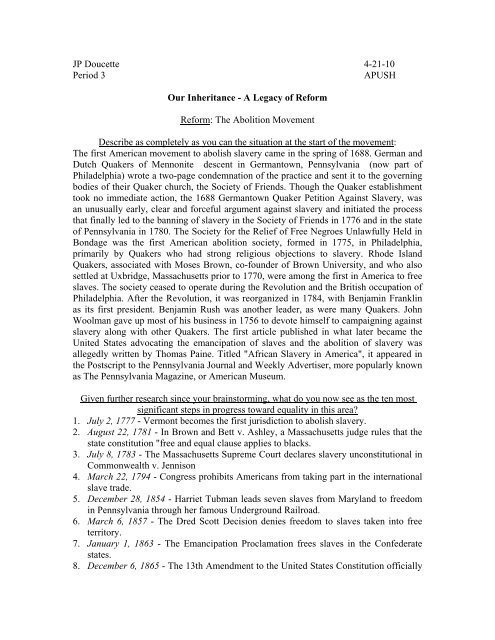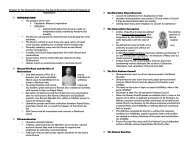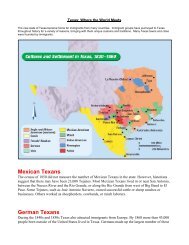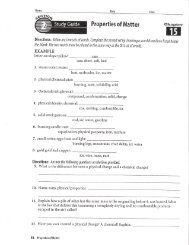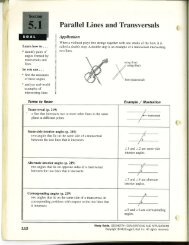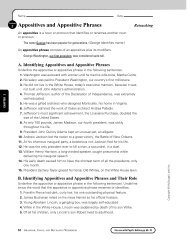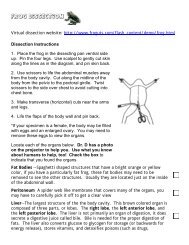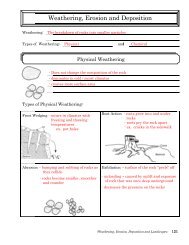JP Doucette 4-21-10 Period 3 APUSH Our Inheritance - A ... - Teacher
JP Doucette 4-21-10 Period 3 APUSH Our Inheritance - A ... - Teacher
JP Doucette 4-21-10 Period 3 APUSH Our Inheritance - A ... - Teacher
You also want an ePaper? Increase the reach of your titles
YUMPU automatically turns print PDFs into web optimized ePapers that Google loves.
<strong>JP</strong> <strong>Doucette</strong> 4-<strong>21</strong>-<strong>10</strong><br />
<strong>Period</strong> 3<br />
<strong>APUSH</strong><br />
<strong>Our</strong> <strong>Inheritance</strong> - A Legacy of Reform<br />
Reform: The Abolition Movement<br />
Describe as completely as you can the situation at the start of the movement:<br />
The first American movement to abolish slavery came in the spring of 1688. German and<br />
Dutch Quakers of Mennonite descent in Germantown, Pennsylvania (now part of<br />
Philadelphia) wrote a two-page condemnation of the practice and sent it to the governing<br />
bodies of their Quaker church, the Society of Friends. Though the Quaker establishment<br />
took no immediate action, the 1688 Germantown Quaker Petition Against Slavery, was<br />
an unusually early, clear and forceful argument against slavery and initiated the process<br />
that finally led to the banning of slavery in the Society of Friends in 1776 and in the state<br />
of Pennsylvania in 1780. The Society for the Relief of Free Negroes Unlawfully Held in<br />
Bondage was the first American abolition society, formed in 1775, in Philadelphia,<br />
primarily by Quakers who had strong religious objections to slavery. Rhode Island<br />
Quakers, associated with Moses Brown, co-founder of Brown University, and who also<br />
settled at Uxbridge, Massachusetts prior to 1770, were among the first in America to free<br />
slaves. The society ceased to operate during the Revolution and the British occupation of<br />
Philadelphia. After the Revolution, it was reorganized in 1784, with Benjamin Franklin<br />
as its first president. Benjamin Rush was another leader, as were many Quakers. John<br />
Woolman gave up most of his business in 1756 to devote himself to campaigning against<br />
slavery along with other Quakers. The first article published in what later became the<br />
United States advocating the emancipation of slaves and the abolition of slavery was<br />
allegedly written by Thomas Paine. Titled "African Slavery in America", it appeared in<br />
the Postscript to the Pennsylvania Journal and Weekly Advertiser, more popularly known<br />
as The Pennsylvania Magazine, or American Museum.<br />
Given further research since your brainstorming, what do you now see as the ten most<br />
significant steps in progress toward equality in this area?<br />
1. July 2, 1777 - Vermont becomes the first jurisdiction to abolish slavery.<br />
2. August 22, 1781 - In Brown and Bett v. Ashley, a Massachusetts judge rules that the<br />
state constitution "free and equal clause applies to blacks.<br />
3. July 8, 1783 - The Massachusetts Supreme Court declares slavery unconstitutional in<br />
Commonwealth v. Jennison<br />
4. March 22, 1794 - Congress prohibits Americans from taking part in the international<br />
slave trade.<br />
5. December 28, 1854 - Harriet Tubman leads seven slaves from Maryland to freedom<br />
in Pennsylvania through her famous Underground Railroad.<br />
6. March 6, 1857 - The Dred Scott Decision denies freedom to slaves taken into free<br />
territory.<br />
7. January 1, 1863 - The Emancipation Proclamation frees slaves in the Confederate<br />
states.<br />
8. December 6, 1865 - The 13th Amendment to the United States Constitution officially
abolished and continues to prohibit slavery and involuntary servitude, except as<br />
punishment for a crime.<br />
9. April 9, 1866 - The first of two Civil Rights Acts passed during Reconstruction<br />
declares that all persons born in the United States, except untaxed Indians, are<br />
citizens and have equal legal and property rights. Adopted over President Andrew<br />
Johnson’s veto, the act sought to counteract the Black Codes adopted in former<br />
Confederate states.<br />
<strong>10</strong>. July 28, 1868 - The 14th Amendment, which extends citizenship to all persons born<br />
in the United States and guarantees due process and equal protection of the law, takes<br />
effect.<br />
What is your thesis to explain the relative success (or lack of it) in this movement?<br />
Through years and years of perseverance and determination, the Abolition<br />
Movement finally found it’s success through the passing of several pieces of legislation<br />
including the Emancipation Proclamation, the Civil Rights Act, and perhaps most<br />
importantly, the 13th and 14th Amendments to the United States Constitution. These<br />
pieces of legislation and the movement as a whole laid the groundwork for not only<br />
future movements regarding the rights of African-Americans, but for all reform<br />
movements collectively.


